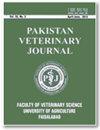求助PDF
{"title":"The Effect of Routine Therapy Alone and Combined with Hyperbaric Oxygen Treatment on Prognostic Factors in Dogs with Acute Pancreatitis","authors":"Idehen Ho","doi":"10.29261/pakvetj/2019.113","DOIUrl":null,"url":null,"abstract":"Received: Revised: Accepted: Published online: July 18, 2018 August 19, 2019 October 20, 2019 November 05, 2019 The aim of this study was to evaluate the effect of supportive treatment combined with hyperbaric oxygen (HBO) therapy in dogs with acute pancreatitis by prognostic factors. Dogs entering the trial were randomly assigned to receive only regular supportive therapy (control group) or combined hyperbaric oxygen therapy with symptomatic and supportive therapy (HBOT group). The regular supportive measurements consisted of intravenous fluid, analgesia, antibiotics, antiemetics, gastric acid suppression, nutritional management, and so on. If the patient had diabetes mellitus, hyperglycemia was controlled by insulin. The dogs of the HBOT group were conducted in hyperbaric animal chamber (PAHI-A, Pan-America Hyperbarics Inc., R.O.C.) and HBO therapy involved 90 min of 100% oxygen treatment at a pressure of 2.5 ATA, once to twice daily for a total of 3 to 5 sessions. There were significant findings regarding to specific canine pancreatic lipase immunoreactivity (Spec cPL) and C-reactive protein (CRP) in the survivors, but no significant differences were found in the non-survivors. The down trend of sequential CRP concentration was noticed in HBOT group. The level of creatinine may be as an important criterion when the patients with AP were first visit clinic. The prognostic factors such as CRP, Spec cPL had a good response to routine combined with HBOT in survivors group. Likewise, the level of Spec cPL was decreased significantly after treatment no matter routine or routine combined with HBOT in survivors group. HBOT combined with symptomatic and routine treatment might improve systemic inflammation probably in canine acute pancreatitis. In survivors group the creatinine levels was significant lower than that in non-survivors group. Therefore, the levels of creatinine can be as prognostic factor in dogs with acute pancreatitis. ©2019 PVJ. All rights reserved","PeriodicalId":19845,"journal":{"name":"Pakistan Veterinary Journal","volume":" ","pages":""},"PeriodicalIF":3.8000,"publicationDate":"2019-10-01","publicationTypes":"Journal Article","fieldsOfStudy":null,"isOpenAccess":false,"openAccessPdf":"","citationCount":"0","resultStr":null,"platform":"Semanticscholar","paperid":null,"PeriodicalName":"Pakistan Veterinary Journal","FirstCategoryId":"97","ListUrlMain":"https://doi.org/10.29261/pakvetj/2019.113","RegionNum":3,"RegionCategory":"农林科学","ArticlePicture":[],"TitleCN":null,"AbstractTextCN":null,"PMCID":null,"EPubDate":"","PubModel":"","JCR":"Q1","JCRName":"VETERINARY SCIENCES","Score":null,"Total":0}
引用次数: 0
引用
批量引用
单纯常规治疗和高压氧联合治疗对犬急性胰腺炎预后因素的影响
接收日期:修订日期:接受日期:在线发布日期:2018年7月18日2019年8月19日2019年10月20日2019年11月5日本研究旨在通过预后因素评估支持性治疗结合高压氧(HBO)治疗犬急性胰腺炎的效果。进入试验的狗被随机分配为只接受常规支持性治疗(对照组)或高压氧治疗与症状和支持性治疗相结合(HBOT组)。常规支持性测量包括静脉输液、镇痛、抗生素、止吐药、胃酸抑制、营养管理等。如果患者患有糖尿病,则通过胰岛素控制高血糖。HBOT组的狗在高压动物室(PAHI-A,Pan-America Hyperbarics股份有限公司,R.O.C.)中进行,HBO治疗包括在2.5 ATA的压力下进行90分钟的100%氧气治疗,每天一到两次,共3到5次。存活者的特异性犬胰脂肪酶免疫反应性(Spec-cPL)和C反应蛋白(CRP)有显著发现,但在非存活者中没有发现显著差异。HBOT组连续CRP浓度呈下降趋势。当AP患者首次就诊时,肌酐水平可能是一个重要的标准。生存组CRP、Spec-cPL等预后因素对常规联合HBOT有良好反应。同样,幸存者组的Spec-cPL水平在治疗后显著降低,无论是常规治疗还是常规联合HBOT治疗。HBOT结合症状和常规治疗可能改善犬急性胰腺炎的全身炎症。存活组的肌酸酐水平显著低于非存活组。因此,肌酸酐水平可以作为犬急性胰腺炎的预后因素。©2019 PVJ。保留所有权利
本文章由计算机程序翻译,如有差异,请以英文原文为准。


